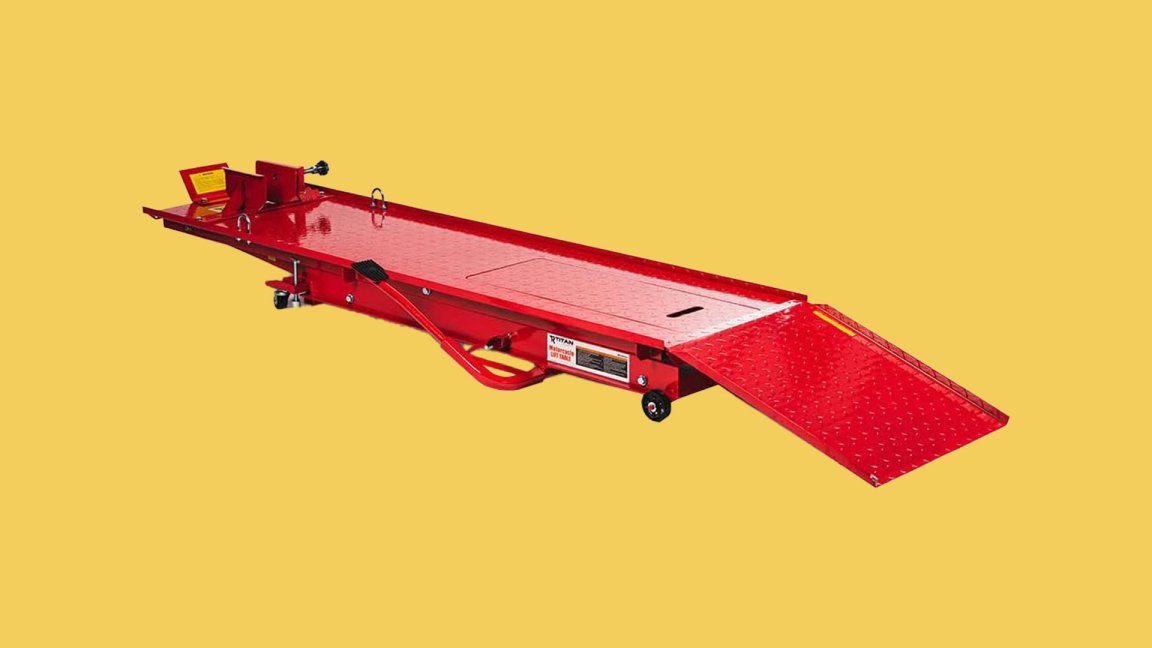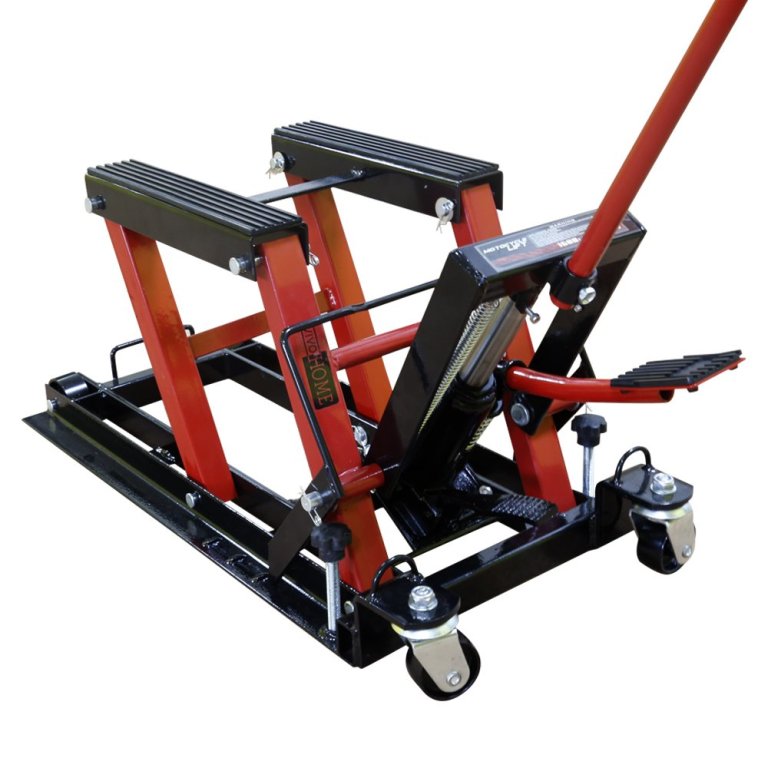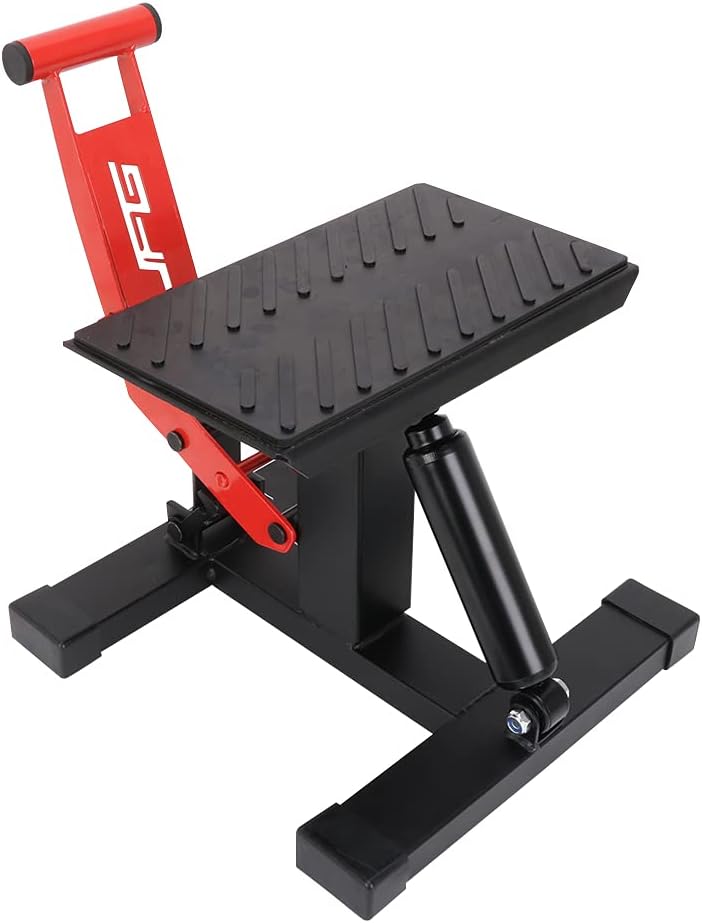We may earn revenue from the products available on this page and participate in affiliate programs. Learn more ›

If you frequently work on your bike, it’s convenient to have a motorcycle lift for basic maintenance. Whether it operates as a scissor lift, a hydraulic jack, or a threaded hoist, the device lifts the bike off the ground and holds it securely in place to provide better, easier access. Some lifts are mobile and portable; others are designed to take up permanent residence on your garage or shop floor.
Whichever motorcycle lift you choose, you’re trusting it to securely support a highly prized vehicle you likely spent thousands of dollars on. So you’d better be confident in your purchase. And that’s what we aim to arm you with in these picks.
Summary List
- Best Overall: Titan Ramps Hydraulic Motorcycle Lift
- Best Value: Extreme Max Motorcycle Scissor Jack
- Honorable Mention: APlusLift MT1500X Motorcycle Lift
- Best For Mobile Repairs: VivoHome Hydraulic Motorcycle Lift
- Best For Dirt Bikes: JFG Racing Motorcycle Dirt Bike Lift
Our Methodology
I don’t own a motorcycle lift simply because I live in an apartment complex, and I prefer to work on my Street Triple at my friend’s house and use his. With that in mind, I’ve put motorcycles on countless lifts in my nearly 20 years of riding.
So, although I didn’t get to test the products on this list, I know what separates the good from the irritating. I reserve the right to change my mind, my answers, and this buying guide when new products come on the market and/or I get the opportunity to do some hands-on testing. As always, everything is up for debate.
Best Motorcycle Lifts: Reviews & Recommendations
Best Overall: Titan Ramps Hydraulic Motorcycle Lift
Pros
- Diamond-plated surface for grip
- Keyhole ports for optional tie-down straps
- 11-gauge steel construction
- Front wheel clamp
- Hydraulic lift that brings ramp up to 34-inches
Cons
- 1,000-pound capacity is relatively low
If you work on motorcycles often, either for yourself or as a side hustle, you need a quality hydraulic lift. Whether in the shop or home garage, Titan Ramps’ 1,000 Pound Capacity Motorcycle Lift Table brings the job up to eye level with a hydraulic mechanism featuring a dual pedal system. Other features include a wheel vice chock, stop plate, and tie-down strap access ports. The diamond-plated surface, made of heavy-duty, 11-gauge steel plate, provides excellent grip, bringing the job up to eye level and making access to the engine and components a breeze.
Many professional-grade lifts cost far more, and cheaper home scissor lifts don’t provide the stability, security, and ease of use regular work requires. While this lift table does have a large footprint, it flattens to floor level quickly and easily.
Best Value: Extreme Max Motorcycle Scissor Jack
Pros
- Operates with any 7/8-inch socket or wrench
- Collapses out of sight
- 1,100-pound capacity
- Durable rubber padding
- Fantastic value
Cons
- Only gives 14-inches of lift
- Manual operation
Most of us aren’t mechanics, and we don’t need a table lift taking up half our garage when we only work on our bikes for casual maintenance and occasional repair. Enter this mighty little scissor lift from Extreme Max. With a surprisingly impressive lift capacity, this tiny workhorse gets your bike 14 inches up off the ground to make access to its components much easier. High-strength worm drive and heavy-duty steel construction work together to lift nearly any road bike, touring bike, or cruiser up to 1,100 pounds. It’s also great for dirt bikes and ADV bikes. It’s not portable, per se, but it can be taken out of the garage and used almost anywhere you need it.
While the 1,100-pound capacity is impressive, it’s important to note that many fully dressed touring bikes push the scales upwards of 1,000 pounds with much of that mass top-loaded in the fairings and luggage compartments. If you ride a Honda Gold Wing, Harley Ultra Glide, or similar, be advised that this mighty mite could be less than stable when loaded with a top-heavy bike.
Honorable Mention: APlusLift MT1500X Motorcycle Lift
Pros
- Extremely heavy-duty construction
- Suitable for multiple powersport machines
- 2-year warranty
- Lifts up to 30 inches
- Butterfly pedal opperation
Cons
- Pricey
- Requires air compressor
If you’re more like a professional mechanic than a DIY lover, the APlusLift MT1500X is the motorcycle lift to go for. I say this because, for most wrenchers, it’s overkill in terms of price and capability. It boasts the highest weight capacity on this list and can handle up to 1,500 pounds. And you can load it up with confidence time and time again, as this model comes with a 2-year warranty. It’s made from 8.8 construction-grade bolts and has a durable e-coated black and powder-coated orange paint finish.
Anti-slip traction tape and a service jack are included in the sale, but this lift requires an air compressor to operate. So, if you don’t already have an air compressor, you’ll have to add it to the bill, which is already pretty significant. Although this lift tips the scales at 550 pounds, operating it couldn’t be easier. There’s a butterfly pedal with an auto-neutral feature, which moves the ramp up and down precise shafts along its scissor frame. This model has an operational lift range of 19.5-30 inches and measures 130 x 48 x 33 inches, making it suitable for multiple powersport machines.
Best For Mobile Repairs: VivoHome Hydraulic Motorcycle Lift
Pros
- 1,500-pound capacity is enough for even the largest machines
- Three-position safety lock
- Casters make it mobile, light weight makes it portable
- Weighs less than 60 pounds
Cons
- Caster wheels make it slightly less stable than a fixed lift
Made from high-quality steel, this rolling motorcycle lift is designed to be easy-to-use, mobile and portable, and strong enough to handle dirt bikes, motorcycles, jet skis, snow mobiles, and ATVs. After a motorcycle has been loaded onto the jack, adjustable locking screws secure the swiveling casters in place. The lift range runs from 4.5-15-inches-high, to bring just about any motorcycle or ATV up to a comfortable level. It comes with a handle, two tie-down straps, and two adapter bars. Best of all, it has a 1,500-pound lifting capacity, so it should be fine for even large cruisers and touring bikes.
The fact that it weighs less than 60 pounds means you can throw it in a trunk or truck bed for roadside repairs. The downside of a rolling motorcycle lift is its stability; we recommend using it only on a level surface and always make sure you lock the wheels in place.
Best For Dirt Bikes: JFG Racing Motorcycle Dirt Bike Lift
Pros
- Lightweight and portable
- Easy to use
- Inexpensive
- Might suffice for small street bikes and scooters
Cons
- Limited lift range
If you’re into motocross, then you know how often breakdowns can happen; you also know how much of a pain it is to lie down on the dirt, mud, sand, or rocks to get to the bottom end of your bike. How often have you wished for a jack stand or lift you can take with you out into the wild? This lightweight, easy-use dirt bike lift from JFG Racing is just the ticket. With foot-pump actuation and a lift capacity of 330 pounds, it’s strong enough to get most any small to midsize dirtbike up into the air so you can access the bottom end. Heck, it should work for most runabout scooters and 125-250cc street bikes, such as the Honda Grom.
We’d be dubious of using it for anything other than sub-250cc dirtbikes, though; the wet weight of larger dirt and ADV bikes and even small 250cc cruisers will push this lift’s capacity to its limit. Also, its lift range is minimal. It’s perfect for throwing in the truck or van for a day on the trails, so you can easily address issues like fork seal leaks and tire plugs and changes. But if you do regular maintenance on small bikes, you may want to look for a steadier, more secure option.
Our Verdict
If you’re a regular motorcyclist who likes to tinker on and maintain your own bike, the Titan Ramps Hydraulic Motorcycle Lift is a fantastic option — if you have room in your garage. If that’s too much motorcycle lift for you, consider the Extreme Max 1000-lb. Motorcycle Scissor Jack. It’s affordable and easy to use for occasional maintenance and tucks out of sight when not in use.
Things You Should Know Before Buying a Motorcycle Lift
Here’s everything you need to know.
Key Features
Lifting Mechanism
The main job of a lift is to get a motorcycle off the ground. In this respect, every motorcycle lift has a jack, a winch, or a motor that hoists motorcycles. Most bike lifts use the same hydraulic technology used by car jacks. The lift mechanism can be either air, hydraulic, or electric. However, it’s worth noting that hydraulic and electric lifts are more expensive and require less effort.
Weight Capacity
Motorcycles are not equal and have different weights. For instance, a Harley-Davidson Road Glide has a weight rating of almost 900 pounds, while a Honda Monkey barely weighs 200. As a rule of thumb, get a lift that weighs twice as much as your bike. Of course, this guideline is fungible but you should always consider that you may occasionally work on a bike other than your own and you may change or upgrade your motorcycle at some point in the future. If you can afford it, size up and give yourself some versatility.
If you own a small dirt bike, look for a jack with at least a 300-pound weight limit. If you want one that also works for ATVs, touring machines, and ADV bikes, shop for one with a weight capacity of 1,500 pounds and above.
Safety Features
When using a motorcycle lift, safety and stability must be the priority. Make sure the lift you buy has a locking mechanism so that it doesn’t drop down on you. The lifting platform should have a rubber coating to prevent the bike from slipping and to protect it from scratches, dents, and other damage. Some lifts come with tie-down straps that can be used to secure bikes. Others have ramps to help load bikes and extension panels to increase workspace.
Lift Range
Before you buy a motorcycle lift, check its lifting height. A jack with adjustable height is better because you’ll need different heights for different tasks. If it’s not adjustable, you may not be able to reach some parts of the bike.
FAQs
You’ve got questions. The Drive has answers.
A: Depends on the lift. Some use threaded bolt or scissor lifts, others use air or hydraulics to raise the bike. Some lifts are hand-powered, while others rely on electricity.
A: It’s possible but absolutely not recommended. Motorcycle lifts are designed specifically for bikes. You want to use a device that will keep you and your bike safe from harm.
A: Small, portable lifts can be as cheap as fifty bucks. Others for garages and shops can cost well over $1,000. For most motorcyclists, a lift in the $150-$750 range will suffice.
A: It’s best to use a lift that’s specifically designed for an ATV. ATVs are typically much heavier than motorcycles, and you don’t want to go beyond a lift’s maximum load capacity or it can fail.







